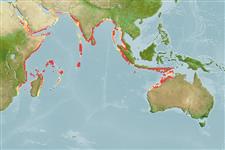>
Eupercaria/misc (Various families in series Eupercaria) >
Lutjanidae (Snappers) > Lutjaninae
Etymology: Lutjanus: Malay, ikan lutjan, name of a fish; indicus: Named for its Indian Ocean distribution..
Environment: milieu / climate zone / depth range / distribution range
Sinh thái học
Biển; Nước ngọt; Thuộc về nước lợ Cùng sống ở rạn san hô; Mức độ sâu 5 - 50 m (Ref. 93093), usually 5 - 15 m (Ref. 93093). Tropical
Indian Ocean: northern continental margin of the Indian Ocean including western Thailand, Myanmar, Andaman Islands, Sri Lanka, India, Gulf of Oman and Arabian Gulf. Western Indian Ocean distribution of L. russellii mentioned in Allen & Talbot, 1985 (Ref. 469) is provisionally referred to as L. indicus; population needs to be reassessed..
Bộ gần gũi / Khối lượng (Trọng lượng) / Age
Maturity: Lm ? range ? - ? cm
Max length : 22.6 cm SL con đực/không giới tính; (Ref. 93093)
Short description
Hình thái học | Sinh trắc học
Các tia vây lưng cứng (tổng cộng): 10; Các vây lưng mềm (tổng cộng): 13-14; Tia cứng vây hậu môn 3; Tia mềm vây hậu môn: 8. This species is distinguished by the following set of characters: D X,13-14 (usually 14); total gill rakers 12-14; body depth 2.5-2.9 in SL; eye 4.2-4.6 in HL; interorbital 5.9-7.0 in HL; the scale rows above the lateral line rise obliquely toward dorsal profile; predorsal scales extending forward nearly to level of rear part of orbit; weakly developed preopercular notch and interopercular knob; upper surface of tongue with central patch of fine granular teeth; vomer with diamond-shaped to narrowly crescent-shaped patch of granular teeth with medial posterior extension; truncate caudal fin; in life it is overall pale grey, grading to silvery white on cheek, opercle, and lower side of body with series of seven dark brown to yellow stripes on posterior head and side, prominent black spot, about 1.2-1.5 size of eye, on posterior back below base of first 6-7 soft dorsal rays, its lowermost part occupying about one scale row below lateral line (Ref. 93093).
This species was observed in coral-reef habitat; generally encountered solitary or in small groups in about 5-15 m depth. It is also taken by trawlers in deeper water (to at least 50 m) and usually appears in fish markets. Few information on juvenile habitat, but suspected to be similar to L. russellii where young are found in brackish mangrove estuaries and lower reaches of freshwater streams (Ref. 93093).
Life cycle and mating behavior
Chín muồi sinh dục | Sự tái sinh sản | Đẻ trứng | Các trứng | Sự sinh sản | Ấu trùng
Allen, G.R., W.T. White and M.V. Erdmann, 2013. Two new species of snappers (Pisces: Lutjanidae: Lutjanus) from the Indo-West Pacific. J. Ocean Sci. Found. 6:33-51. (Ref. 93093)
IUCN Red List Status (Ref. 130435)
Threat to humans
Harmless
Human uses
Thêm thông tin
Tên thường gặpCác synonym ( Các tên trùng)Trao đổi chấtCác động vật ăn mồiĐộc học sinh tháiSự tái sinh sảnChín muồi sinh dụcĐẻ trứngTổng số cá thể đẻ trứngSự sinh sảnCác trứngEgg development
Age/SizeSự sinh trưởngLength-weightLength-lengthLength-frequenciesSinh trắc họcHình thái họcẤu trùngSự biến động ấu trùngBổ xungSự phong phúBRUVS
Các tài liệu tham khảoNuôi trồng thủy sảnTổng quan nuôi trồng thủy sảnCác giốngDi truyềnElectrophoresesDi sảnCác bệnhChế biếnNutrientsMass conversion
Các công cụ
Special reports
Download XML
Các nguồn internet
Estimates based on models
Preferred temperature (Ref.
123201): 26.8 - 29.3, mean 28.3 °C (based on 684 cells).
Phylogenetic diversity index (Ref.
82804): PD
50 = 0.5000 [Uniqueness, from 0.5 = low to 2.0 = high].
Bayesian length-weight: a=0.01230 (0.00706 - 0.02143), b=2.94 (2.80 - 3.08), in cm total length, based on LWR estimates for this species & Genus-body shape (Ref.
93245).
Mức dinh dưỡng (Ref.
69278): 3.8 ±0.6 se; based on size and trophs of closest relatives
Thích nghi nhanh (Ref.
120179): Chiêù cao, thời gian nhân đôi của chủng quần tối thiểu là dưới 15 tháng (Preliminary K or Fecundity.).
Fishing Vulnerability (Ref.
59153): Low vulnerability (18 of 100).
